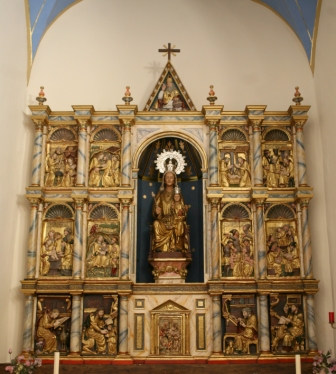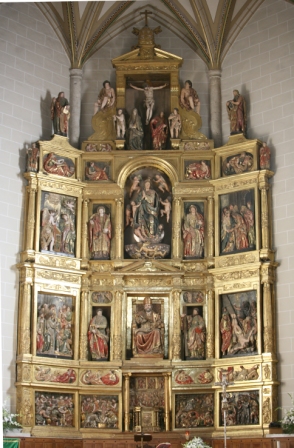October 3, 2014
Global Seminars & Invited Speaker Series
ROUTE OF THE RENAISSANCE OF NAVARRA
The Cultural Heritage of the Renaissance in Mendigorría
D. Ignacio Miguéliz Valcarlos
Chair of Navarrese Heritage and Art
The imprint of the Renaissance in Mendigorría is marked by three main milestones: the construction of the church of San Pedro, its main altarpiece, and the main altarpiece of the church of Santa María. Together with these three great works we find other pieces such as the altarpieces of Our Lady of the Rosary and the Risen Christ, or the images of Saint Sebastian, Saint John or Saint James.
The earliest sample of the new style will be represented by the main altarpiece of the church of Santa María, the work of the master Terín and the painter Diego Polo. Made under the patronage of Juan de Eguía, this piece was not created for this church, but was transferred from that of the convent of La Merced in Estella. Articulated by means of a bench and two bodies of five streets, and attic, it presents a rich iconography centered on the life of the Virgin, accompanied on the bench by the four Evangelists framing the Descent into the Tabernacle, while in the first body are distributed the presentation in the Temple, the Flight into Egypt, the Slaughter of the Innocents and Jesus among the doctors, and in the second the Annunciation, the Visitation, the Nativity and the Adoration of the Kings, topped by the Eternal Father in the attic.

Main altarpiece of the church of Santa María, originally from the convent of La Merced in Estella.
(Photo: Andoni San Juan)
In relation to the church of San Pedro, which underwent important transformations during the 18th and 19th centuries that altered its physiognomy, we must mention the stonemasons Diego de Areso, Juan de Areso and Juan de Mazquiarán, who were in charge of building the church between 1540 and 1601, and Antonio de Arocechea and Juan de Aguirre, who finished the construction of the tower and the choir, totally transformed during the Baroque period. At that time the façade was also modified, which was adapted to the new eighteenth-century façade, maintaining the structure of the altarpiece façade but with a new baroque language, in which the sculptures made in 1559 by the sculptor Juan de Oberón were used, with the representations of Saint Peter, Saint Paul and Saint Andrew, accompanied by Temperance, Charity and Justice, as well as the heads of angels and two atlantes.
Finally, the main altarpiece of the church of San Pedro, the work of Bernabé Imberto, made between 1594 and 1610, is one of the best examples of Romanesque sculpture in Navarre. Following the models of Juan de Anchieta, we find ourselves before an altarpiece of vertical lines, composed of square boxes that are distributed in bank, two bodies, with respective entrecuerpos, more attic, all this divided in five streets. On the bench are distributed scenes of the Passion of Christ: the Last Supper, the Lavatory, the Prayer in the Garden and the Arrest, around a rich tabernacle with allegorical figures of the Virtues and scenes related to the Eucharist and the Passion of Christ: the Resurrection, the Descent of Christ to Limbo, the Descent, the Veronica, the Flagellation, the Sacrifice of Isaac, Abraham and Isaac on the way to Mount Moriah, Abraham and Melchizedek and Abraham and Abimelech. In the first body themes related to St. Peter, titular of the parish, on the sides the submission of the keys and the Crucifixion, and in the center the seated figure of the first pope framed by those of St. Paul and St. Andrew, with their respective martyrdoms on them, while in the first between-body are distributed the Fathers of the church and saints. In the second body there are scenes from the life of the Virgin, with the Assumption in the central street framed by two martyr Saints, and the Annunciation and the Visitation on the sides, and in the interbody prophets and virtues with St. Stephen and a Saint deacon at the ends. While in the attic is the Calvary, Christ crucified between the Virgin and St. John, and on the sides the figures of Moses and David.

Main altarpiece of the parish of San Pedro
Romanesque work by Bernabé Imberto (1594 and 1610).
(Photo: Andoni San Juan)
